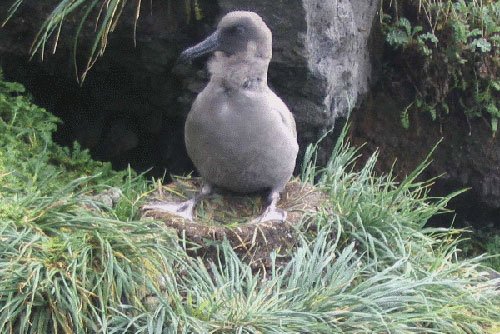The ornithological field assistants currently on South Africa's Marion Island, one of the Prince Edward Islands in the southern Indian Ocean, have been busy this summer. Field workers have been undertaking island-wide counts of ACAP-listed albatrosses and petrels and are also following colour-banded birds at marked nests in a number of study colonies.
Last month a round-island trip, supported by overnight stays in coastal field huts, resulted in total counts of Wandering Albatross Diomedea exulans chicks of the 2012 cohort and of incubating Southern Giant Petrels Macronectes giganteus. These two species breed in similar habitats on the coastal plains, so can be reasonably easily counted during the same survey. Meanwhile in the south of the island that is a day's walk from the weather station on the east coast a long-term study colony of Grey-headed Albatrosses Thalassarche chrysostoma is being followed on a daily basis during incubation - made possible by a nearby field hut. Previously in late September a round-island trip had counted early-laying Northern Giant Petrels M. halli.
With the two sooty albatrosses of the genus Phoebetria being identified as relatively little studied compared to the great albatrosses and mollymawks two new demographic studies are being set up this austral summer, concentrating at first on the more numerous, coastally-breeding Sooty Albatross P. fusca. Marion Island is one of the few localities where both the Sooty and Light-mantled Sooty P. palpebrata Albatrosses can be studied together. Breeding success for these two species will be determined and attempts will be made to band both adults and chicks so that survival can later be estimated.
Also on the go are regular checks of marked nests in three Wandering Albatross breeding areas and one Northern Giant Petrel one that have been followed every year since the late 1970s/early 1980s. Chicks that survive in these four study areas will all be metal-banded before they fledge. Total-island counts of incubating Grey-headed, Sooty and Light-mantled Sooty Albatrosses are also undertaken every year. A repeat count of large chicks of the Grey-heads towards the end of summer will allow breeding production for the island to be known. Lastly, early next year the 2013 cohort of incubating Wanderers will be counted on yet another round-island hike that will take approximately a week to complete - and the colour-banded birds in the study areas checked and their nests marked once more.

Waiting to be counted? A Sooty Albatross chick sits up for the camera on Marion Island
Photograph by Marienne de Villiers
ACAP-listed burrowing petrels are not being neglected. The winter-breeding Grey Petrels Procellaria cinerea that have been under study (click here) have now fledged their chicks and so attention has switched to the summer-breeding White-chinned Petrels P. aequinoctialis, with 60 burrows being checked for signs of occupancy. A recent publication has estimated that the population of this species on Marion Island is of the order of 24 000 breeding pairs (click here).
At-sea tracking is being undertaken on both sooty albatross species using GLS loggers (global location sensors that work with light intensity; click here), with plans to place more on Grey-headed Albatrosses and White-chinned Petrels this summer. Ten archival loggers deployed on White-chins three years ago have been recently recovered and all have yielded data. In addition, a few Grey Petrels were tracked during the winter months.
Research on albatrosses and petrels at the Prince Edward Islands is undertaken by the Percy FitzPatrick Institute, University of Cape Town and by Oceans and Coasts, Department of Environmental Affairs. Primary funding support and scientific management comes from South Africa's National Research Foundation on behalf of the Department of Science and Technology (DST) with logistic support coming from the Department of Environmental Affairs, which together operate as the South African National Antarctic Programme (SANAP).
With thanks to Robert Crawford and Peter Ryan for information.
John Cooper, ACAP Information Officer, 20 November 2012

 English
English  Français
Français  Español
Español